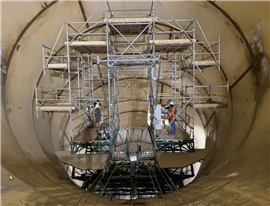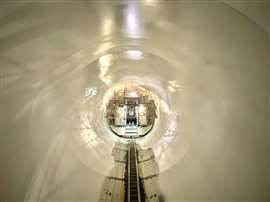Riding the Penstock roller coaster: SAIA Innovation Project of the Year Award
November 07, 2023
To apply corrosion-resistant coating at a British Columbia hydroelectric power plant, BrandSafway came up with a unique and mobile solution
Pierre Grenier, P.Eng., Technical Director Infrastructure, BrandSafway, reports on an innovative motorized solution that helped improve access at BC Hydro’s Site C Clean Energy Project – and see BrandSafway take home an award for its work.
 The BC Hydro Site C Clean Energy Project features six penstocks that measure 32 feet in diameter and are 300 feet long. (All photos: BrandSafway)
The BC Hydro Site C Clean Energy Project features six penstocks that measure 32 feet in diameter and are 300 feet long. (All photos: BrandSafway)
When it comes to renewable energy, British Columbia boasts abundant water and mountain elevations to create runoff. As a result, the province generates about 87% of its electricity from hydroelectric sources. It currently has about 16,000 megawatts (MW) of hydroelectric capacity, most of which is located on the Columbia River and the Peace River. Site C, a new hydroelectric facility on the Peace River, will add another 1,100 MW when it is completed in 2025. According to BC Hydro, the provincial Crown corporation responsible for energy, the Site C will add enough energy to power the equivalent of about 450,000 homes per year.
To generate power, penstocks — giant water intake conduits measuring 10 meters in diameter and about 100 meters long — direct water from the reservoir above to six 183-megawatt hydro turbines below. The penstocks are fabricated from large steel plate sections, rolled to shape, and then welded together. Next, they need to have a corrosion-resistant coating applied, which is easier said than done. Like a roller coaster, the penstocks slope at 15 degrees before plummeting at a 45-degree angle, then leveling out just before the turbines.
While traditional scaffold could be used to access the penstocks and apply the coatings, it would come at a high cost, due to the number of components required. It would also extend construction time, because more components take more time to move. In addition, descending 100 meters at a steep angle is hard on workers and increases hazards.
With these factors in mind, Site C General Contractor Groupe LAR retained BrandSafway (with representation from its Aluma Systems, Hydro-Mobile, Winsafe and Spider divisions) to provide access for Site C. Specifically, Groupe LAR asked if BrandSafway could design and provide a mobile solution.
 A schematic of the self-leveling hydraulic platform. It stays level even as the chassis base travels at inclines up to 45 degrees.
A schematic of the self-leveling hydraulic platform. It stays level even as the chassis base travels at inclines up to 45 degrees.
Groupe LAR wanted its workers to be able to:
- Travel up and down and access the length of the penstock safely and efficiently.
- Weld, paint, inspect, repair and sandblast the entire penstock circumference.
- Carry coating equipment and light tooling.
To meet these needs, the access team custom-engineered a motorized carrier (trolley) combined with a hydraulic self-leveling platform. The platform would support multiple levels of Systems Scaffold with a dead load of up to 8,000 pounds and a live load of up to 1,500 pounds for five workers and equipment.
The trolley chassis was fabricated from high-strength steel and moved on four sets of high-density solid rubber wheels. The main deck flooring featured an aluminum frame and heavy-duty plywood, divided into left and right platforms. Mobility is provided by two electric hoists synchronized to operate in parallel.
Safety measures included an emergency descent system in case of power failure, overspeed and overload devices, a self-levelling floor deck system and upper travel limit switches.
Self-leveling function
The mobile platform functions similarly to a scissor lift mechanism and automatically keeps the platform level, even at steep angles.
In addition to improving worker productivity and comfort, the self-leveling mobile platform:
- Delivered the lowest total installed cost compared to erecting supported scaffold throughout the 100-meter length of the penstocks.
- Reduced overall time for the coating application (Fig. 4), especially as the mobile platform could be moved efficiently between the six penstocks.
- Decreased the likelihood of a trip or fall incident as workers traversed from top to bottom.
- Easily moved equipment and materials without straining workers.
Shuttle platform
A shuttle platform was used to transport four workers and light equipment, with a maximum capacity of 1,500 pounds, between the bottom of the penstock and the main work platform. This platform limits the movement of the main platform in order to optimize work on it and also is designed to carry a maximum of five people in case of evacuation.
 Even though the penstock descends at a rollercoaster-like angle, an inclinometer combined with hydraulic cylinders and a closed-loop digital control automatically keeps the platform level.
Even though the penstock descends at a rollercoaster-like angle, an inclinometer combined with hydraulic cylinders and a closed-loop digital control automatically keeps the platform level.
The platforms transported workers throughout all six months of the project and will improve future penstock construction and maintenance projects. In 2022, this unique, innovative and first-of-its-kind access solution was awarded the Scaffold & Access Industry Association’s Innovation Project of the Year Award.
Project scope and details
The Site C Clean Energy Project will be a third dam and hydroelectric generating station on the Peace River in northeast B.C. It will provide 1,100 megawatts (MW) of capacity and produce about 5,100 gigawatt hours (GWh) of electricity each year — enough energy to power the equivalent of about 450,000 homes or 1.7 million electric vehicles per year in British Columbia.
As the third project on one river system, Site C will gain significant efficiencies by taking advantage of water already stored in the Williston Reservoir. This means Site C will generate about 35 per cent of the energy produced at W.A.C. Bennett Dam, with only five per cent of the reservoir area.
In December 2014, the Site C project received approval from the provincial government to proceed to construction.
This decision followed a rigorous and independent environmental assessment by the federal and provincial governments, which included a Joint Review Panel process. The conclusion of the three-year environmental review was that the effects of the Site C project are justified by the long-term benefits it will provide.
Construction started in summer 2015, and the project is on track to have all six generating units fully in-service by November 2025.
 Looking downstream at the platform after coating has been applied.
Looking downstream at the platform after coating has been applied.
Once built, Site C will be a source of clean, reliable and affordable electricity in B.C. for more than 100 years.
The project design for the Site C Clean Energy Project includes the following key components:
- Access roads in the vicinity of the site and a temporary construction access bridge across the Peace River at the dam site.
- Construction of two temporary cofferdams across the main river channel to allow for construction of the earthfill dam.
- Worker accommodation at the dam site, with other workers being housed off site and in the region.
- The realignment of six segments of Highway 29 over a total distance of 30 kilometers.
- Shoreline protection at Hudson’s Hope.
- Two new 500 kilovolt AC transmission lines that will connect the Site C facilities to the existing Peace Canyon Substation, along an existing right-of-way.
- An 800-metre roller-compacted-concrete buttress to enhance seismic protection.
- An earthfill dam, approximately 1,050-meters-long and 60-meters-high above the riverbed.
- A generating station with six 183 MW generating units.
- An 83-kilometre-long reservoir that will be, on average, two to three times the width of the current river.
STAY CONNECTED



Receive the information you need when you need it through our world-leading magazines, newsletters and daily briefings.
CONNECT WITH THE TEAM







